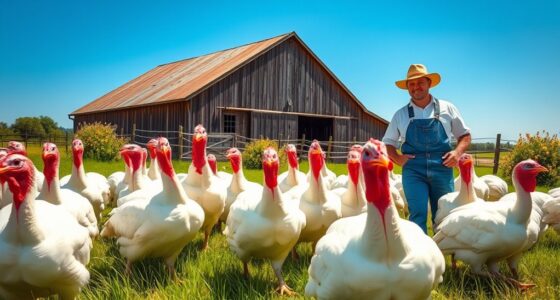To protect your apiaries during monarch migration, stay aware of pesticide drift risks from nearby farms, especially during windy weather or peak application periods. Use buffer zones and native plants to shield bees from residues. Timing pest control practices carefully and monitoring pesticide levels can reduce exposure. Supporting policies that limit drift and community efforts to restore habitats also help. To learn how to implement these strategies effectively, see what steps you can take next.
Key Takeaways
- Establish buffer zones with native vegetation around apiaries to reduce pesticide drift exposure.
- Monitor weather conditions and wind patterns before pesticide application to prevent drift into migration pathways.
- Coordinate with local farmers to schedule pesticide applications during calm weather and outside peak migration times.
- Promote organic farming and pesticide alternatives near monarch habitats to minimize chemical drift risks.
- Educate community members and farmers about drift mitigation, including proper application techniques and timing.
Understanding Pesticide Drift and Its Pathways

Pesticide drift occurs when tiny droplets or particles from agricultural sprays are carried by the wind beyond their intended target areas. The way pesticides are formulated influences drift potential—factors like droplet size and viscosity matter. Fine, sprayable formulations are more prone to drift, especially on windy days. To reduce this, drift mitigation techniques are essential, such as adjusting application timing, using smaller nozzles, or applying pesticides during low wind conditions. Proper pesticide formulation can also minimize drift; for example, using formulations designed to produce larger droplets helps keep chemicals closer to the target. Understanding how pesticide properties interact with environmental conditions allows you to implement effective strategies, safeguarding nearby ecosystems like monarch habitats from unintended chemical exposure. Additionally, awareness of ethical hacking principles can help develop better safety protocols by identifying vulnerabilities in pesticide application equipment or procedures.
The Impact of Pesticides on Monarch Butterflies

Although monarch butterflies are essential pollinators and indicators of healthy ecosystems, their populations are increasingly threatened by chemical exposure. Pesticides, especially neonicotinoids and glyphosate, can harm monarchs at all life stages, reducing survival rates and disrupting migration. To support monarch health, you can advocate for pesticide alternatives that are less harmful to pollinators. Additionally, promoting monarch habitat preservation ensures safe breeding and feeding grounds, decreasing their vulnerability. Consider these actions:
- Avoid using harmful pesticides near key migration corridors.
- Support organic farming practices with pesticide alternatives.
- Preserve and restore native milkweed and nectar plant habitats to enhance pollinator resilience. Implementing integrated pest management strategies can reduce reliance on chemical pesticides, further protecting monarchs from harmful exposure. Promoting pollinator-friendly practices in agriculture and gardening can also contribute to their conservation efforts. Engaging in habitat restoration projects can create additional safe spaces for monarchs to thrive. Recognizing the importance of ecological balance helps reinforce efforts to protect pollinators from chemical threats.
How Pesticide Drift Affects Beekeeping and Apiaries

Ever wondered how pesticide drift impacts beekeeping and apiaries? When pesticides drift into your apiary, they leave behind pesticide residues on flowers, plants, and hive surfaces. These residues can be ingested by bees, leading to weakened bee health and increased vulnerability to diseases. Pesticide residues disrupt foraging behavior, impair navigation, and reduce colony strength. As a beekeeper, you might notice declining hive productivity or sudden bee mortality, directly linked to pesticide drift. Even low levels of pesticide residues can accumulate over time, compounding effects on bee health. Understanding pesticide residue accumulation is essential for developing effective mitigation strategies. Additionally, ongoing research highlights how pesticide exposure can have long-term effects on bee populations and ecosystem health. Proper hive maintenance and regular monitoring are crucial in identifying and reducing pesticide impacts. Continuous vigilance is necessary because pesticide contamination can occur through various environmental pathways, making comprehensive management vital for apiary health. Maintaining awareness of pesticide drift patterns can help beekeepers anticipate and respond to potential threats more effectively. Protecting your apiaries involves understanding how drift spreads and taking proactive measures to minimize exposure. Recognizing these impacts helps you defend your colonies and maintain healthy, productive hives in pesticide-prone environments.
Identifying High-Risk Areas for Pesticide Contamination

To identify high-risk areas for pesticide contamination, you should consider nearby agricultural zones where chemicals are frequently applied. Pay attention to prevailing wind patterns that can carry pesticides into migration paths, increasing exposure risks. Additionally, seasonal application trends can help predict when and where contamination is most likely to occur. Implementing effective wall organization systems can also help monitor environmental factors that influence pesticide drift in sensitive apiary locations. Regularly reviewing regulatory guidelines can further enhance protection measures for apiaries in these high-risk areas.
Nearby Agricultural Zones
Nearby agricultural zones pose a significant risk to migrating monarchs because pesticide use in these areas can contaminate the environment they travel through. You should identify high-risk zones where chemicals may drift into monarch habitats. These zones often involve conventional farming, which relies heavily on synthetic pesticides. To reduce risks, consider supporting or advocating for organic farming practices in nearby fields, as they use pesticide alternatives that are less harmful to pollinators. Additionally, implementing pesticide drift mitigation measures can help prevent chemical exposure to migrating butterflies.
- Locate farms near migration paths and nesting sites.
- Encourage farmers to adopt organic or integrated pest management practices.
- Promote community efforts to establish pesticide-free buffer zones.
Prevailing Wind Patterns
Prevailing wind patterns play a crucial role in determining which areas are most vulnerable to pesticide drift during monarch migration. You need to understand how wind direction influences the movement of airborne pesticides, especially when weather patterns favor strong, consistent winds from agricultural zones. During certain times of the year, prevailing winds may carry pesticides toward your apiaries, increasing contamination risk. Monitoring local weather patterns helps you identify high-risk areas where pesticides are more likely to drift. By paying attention to wind direction forecasts, you can anticipate potential exposure and take proactive measures to protect your bees. Recognizing these patterns allows you to better plan apiary placements and timing, minimizing pesticide contact during critical migration periods. Additionally, understanding electric bike horsepower can help appreciate the importance of efficient transportation and AI security technologies in managing apiary safety during migration seasons. Being aware of pesticide drift patterns further emphasizes the need for vigilant observation of environmental conditions during migration times.
Seasonal Application Trends
Have you noticed how pesticide application peaks during certain times of the year? These seasonal application trends are closely tied to crop scheduling and timing considerations. Understanding when pesticides are most heavily applied helps you identify high-risk areas for contamination. Additionally, being aware of relationship warning signs can help monitor the health of nearby ecosystems affected by pesticide drift. Incorporating natural materials in surrounding landscapes can also serve as a buffer to reduce drift impact.
Strategies for Farmers to Minimize Pesticide Drift

To effectively reduce pesticide drift, farmers should adopt a combination of practical strategies that prevent chemicals from spreading beyond target areas. One effective approach is implementing crop rotation, which can reduce reliance on chemical pesticides and improve soil health. Organic farming practices also minimize pesticide use overall, decreasing drift risks. Additionally, consider timing applications carefully—preferably during calm weather—and choosing less volatile pesticides. Proper equipment calibration ensures precise application, reducing overspray.
| Strategy | Benefit |
|---|---|
| Crop rotation | Lowers pesticide dependence, reduces drift potential |
| Organic farming | Eliminates synthetic chemicals, minimizes drift risk |
| Weather timing | Avoids applying pesticides during windy conditions |
Creating Buffer Zones to Protect Pollinators

Did you know that creating buffer zones around your fields can substantially protect pollinators from pesticide exposure? By establishing vegetative buffers, you can reduce drift and provide safe foraging areas. Focus on native plant restoration within these zones to support local pollinators and strengthen habitat connectivity. This approach not only minimizes pesticide contact but also encourages healthy pollinator populations. Consider these key strategies:
- Plant native flowering species to offer continuous nectar sources.
- Design buffer zones to serve as corridors, linking fragmented habitats.
- Incorporate diverse vegetation to support a variety of pollinators and foster resilient ecosystems.
- Understanding pesticide drift can help inform better buffer zone placement and design to maximize pollinator protection. Additionally, implementing monitoring techniques can assess the effectiveness of these zones over time.
Implementing these steps enhances pollinator safety, sustains biodiversity, and ultimately benefits your farming system.
Monitoring and Testing for Pesticide Residues

Monitoring and testing for pesticide residues are essential steps to guarantee the safety of your crops, pollinators, and consumers. Regular pesticide detection helps identify contamination early, preventing harm to monarchs and bees. By conducting residue analysis on soil, water, and plant samples, you can pinpoint the presence of harmful chemicals and evaluate their levels. This proactive approach allows you to assess whether pesticide applications exceed safe thresholds and adjust practices accordingly. Using sensitive testing methods ensures accurate results, giving you confidence in your pesticide management strategies. Keeping track of residue levels also supports compliance with regulations and promotes sustainable farming. Additionally, understanding the effects of pesticide drift on surrounding ecosystems is crucial for developing effective mitigation strategies. Employing advanced testing technology can improve detection accuracy and help you respond promptly to potential issues. Keeping track of residue levels also supports compliance with regulations and promotes sustainable farming. Ultimately, consistent monitoring helps protect pollinator health, preserves your apiaries, and maintains the integrity of your ecosystem.
Collaborating for Better Pest Management Practices

Collaborating with neighbors, local farmers, and conservation groups can substantially improve pest management practices on your farm. Working together allows you to explore pesticide alternatives that are less harmful to pollinators and the environment. Consider choosing an apiary location away from high-risk pesticide zones to protect your bees. Here are three ways to enhance your efforts:
- Share knowledge about pesticide alternatives that minimize drift risks.
- Coordinate planting schedules to reduce simultaneous pesticide applications.
- Establish buffer zones around apiaries to prevent pesticide drift from neighboring fields.
Legislative Measures and Policy Initiatives

Legislative measures and policy initiatives play a essential role in protecting monarch migration by establishing standards and regulations that limit pesticide use and promote habitat conservation. You can support efforts that enforce proper pesticide labeling, ensuring farmers and applicators understand the risks pesticides pose to pollinators. Strong policies encourage the development and implementation of safer alternatives, reducing harmful drift. Legislative advocacy is key—you can contact lawmakers to push for laws that restrict or ban pesticide application during critical migration periods. Additionally, policies that incentivize habitat preservation and restoration directly benefit monarch populations. By staying informed and engaging with policymakers, you help create a regulatory environment that prioritizes pollinator safety and migratory pathways, ultimately strengthening monarch conservation efforts.
Promoting Public Awareness and Community Engagement

You can make a difference by participating in community outreach efforts that raise awareness about monarch migration. Educational campaigns can inspire others to protect local habitats and support conservation. Together, these strategies empower communities to take meaningful action for monarch preservation.
Community Outreach Strategies
How can communities effectively raise awareness about monarch migration and encourage public participation? You can harness community outreach by organizing local events, promoting urban beekeeping, and supporting native plant restoration. These strategies create direct engagement and foster a sense of shared responsibility.
Consider these approaches:
- Host workshops on urban beekeeping and native plant gardens to educate residents.
- Collaborate with local schools to integrate monarch conservation into curricula.
- Use social media campaigns to highlight community efforts and success stories.
Engaging residents through hands-on activities helps them see their impact. By emphasizing native plant restoration and urban beekeeping, you build a stronger, more conscious community dedicated to protecting monarchs from pesticide drift and supporting pollinator health.
Educational Campaign Initiatives
Educational campaign initiatives play a essential role in raising awareness about monarch migration and inspiring community action. By informing the public about bee health and the impact of pesticide regulations, you can foster responsible behaviors. Campaigns can include workshops, social media outreach, and local events that emphasize the importance of protecting pollinators. These efforts encourage communities to support pesticide policies that minimize drift and promote healthier habitats for monarchs and bees alike.
| Action Step | Key Focus |
|---|---|
| Community Workshops | Educate on bee health and pesticide impacts |
| Social Media Campaigns | Raise awareness and share success stories |
| Local Events & Outreach | Engage residents in conservation efforts |
Frequently Asked Questions
How Can Beekeepers Effectively Document Pesticide Exposure Incidents?
To effectively document pesticide exposure incidents, you should practice meticulous beekeeping record keeping, noting dates, locations, and symptoms observed. When an incident occurs, complete detailed pesticide incident reports, including pesticide types, application methods, and environmental conditions. Regularly update your records and photographs as evidence. This thorough documentation helps you track patterns, supports investigations, and guarantees accurate communication with authorities or fellow beekeepers, safeguarding your apiaries.
What Are Emerging Technologies for Detecting Pesticide Drift Near Apiaries?
Emerging technologies like drone patrols and sensor networks are revolutionizing how you detect pesticide drift near apiaries. Drones can quickly survey large areas, capturing real-time imagery and data, while sensor networks monitor air quality continuously. These tools allow you to identify pesticide presence early, enabling swift action to protect your bees. By integrating these technologies, you can proactively manage risks and guarantee your apiaries remain safe from harmful pesticide exposure.
How Do Different Pesticide Types Vary in Their Impact on Pollinators?
Different pesticide types vary greatly in their impact on pollinators due to pesticide toxicity and pollinator sensitivities. For example, neonicotinoids are highly toxic and affect bee navigation and reproduction, while fungicides pose less risk. You should consider these differences when choosing pesticides, as some may harm pollinators more than others. Understanding pesticide toxicity helps you safeguard pollinators and ensure healthy ecosystems and productive apiaries.
Are There Specific Times of Year When Pesticide Drift Risk Is Highest?
Imagine you’re back in the 1800s, watching fields bloom—pesticide drift risk peaks during spring application and fall spraying. These times pose the greatest threat to pollinators, as pesticides are most actively applied when crops are growing or being harvested. You should be extra cautious during these periods, implementing buffer zones and timing applications carefully to safeguard apiaries and ensure pollinator health.
What Role Do Native Plant Corridors Play in Protecting Monarchs and Bees?
Native plant corridors are essential for supporting pollinator habitat restoration, especially for monarchs and bees. By planting native species along these corridors, you create safe pathways that offer nectar, pollen, and shelter. These corridors help protect pollinators from pesticide drift, providing refuge and food sources during migration and active periods. Incorporating native plant corridors into your landscape promotes healthier ecosystems and supports pollinator populations naturally.
Conclusion
By staying vigilant and adopting best practices, you can act as a shield for our pollinators, safeguarding both monarchs and bees from pesticide drift. Think of your efforts as planting seeds of change—each step you take helps nurture a healthier environment where these essential insects can thrive. Together, our actions weave a safety net, ensuring their flight continues unhindered, reminding us that even small steps can create ripples of lasting impact.










